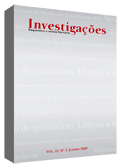Le choix typographique
Resumo
O autor mostra neste artigo que a semiótica da escolha tipográfica dependede parâmetros estilísticos oriundos da tradição da tipografia europeia. Até omomento, a escolha tipográfica era descrita em termos de conotação. Renova-seaqui completamente esta perspectiva colocando-se no cruzamento da paradigmáticados estilos de caracteres (cujos traços distintivos são contínuos ou discontínuos,cumulativos ou nao cumulativos) e da axiologia dos valores éticos atribuídos a cadaum destes traços pela doxa dos impressores. A tipologia complexa que daí resultase aplica principalmente ao texto e ao conjunto de títulos da imprensa e das obrasimpressas, mas ela pode também ser aplicada à publicidade.Referências
ARABYAN, Marc. 1997. Le Prêt-à-clicher: Typographie et mise en pages. Paris: L’Harmattan.
______. 2000. Lire l’image. Paris: L’Harmattan.
______. 2006. La mise en page des pages de publicité. Limoges: Lambert-Lucas.
______.; CHOI, Yong-Ho. 2007. Alphabet latin, alphabet coréen: deux sémiotiques. Limoges: Lambert-Lucas.
BAINES, Phil; HASLAM, Andrew. 2002. Type and typography. New York: Watson-Guptill Publications.
BARTHES, Roland. 1965. Eléments de sémiologie. Paris: Denoël/Gonthier.
______. 1970. L’Empire des signes. Genève: Skira.
BLANCHARD, Gérard. 1979. Pour une sémiologie de la typographie. Andenne
(Belgique): Rémy Magermans.
CARTER, Harry. 2002. A view of early typography up to about 1600. réédité par James Mosley. London: Hyphen Press. [1969]
CARTER, Rob; DAY, Ben; MEGGS, Philip. 2002. Typographic design: form and communication. 3 ed. Hoboken (NJ): John Wiley & Sons.
CUNHA, Doris; ARABYAN, Marc. La ponctuation du discours direct des origines à nos jours. L’Information grammaticale, n° 102, p. 35-45.
FELICI, James. 2003. The Complete Manual of typography: A Guide to setting perfect type.
Berkeley (Cal.): Pitchpit Press (Adobe Press Books); trad. française Paris: Pitchpit Press (Adobe Press Books).
FLOCH, Jean-Marie. 1985. Petites mythologies de l’oeil et de l’esprit. Paris et Amsterdam: Hadès et Benjamins.
______. 1990. Sémiotique, marketing et communication. Paris: Puf.
______. 1995. Identités visuelles. Paris: Puf.
FRAENKEL, Béatrice. 1998. Ecriture et connotation: ce qui est écrit dans l’écrit. In LAPACHERIE, Jean-Gérard. Propriétés de l’écriture. Publications de l’Université de Pau, p. 95 et s.
FRUTIGER, Adrian. 1983. Des signes et des hommes. 2 ed. Lausanne: Delta et Spes.[1978]
______. 2003. A bâtons rompus: ce qu’il faut savoir du caractère typographique. 2 ed.
Méolans-Revel: Atelier Perrousseaux éditeur. [2001]
HJELMSLEV, Louis. 1968. Prolégomènes à une théorie du langage. Paris: Minuit. [1943]
LAWSON, Alexander. 2002. Anatomy of a typeface. Boston: David R. Godine. [1990]
LEFEVRE, Théotiste. 1999. Guide pratique du compositeur et de l’imprimeur typographes. Réédité par Marc Arabyan. Paris: L’Harmattan, collection “Les Introuvables”. [1883]
PARIS, Muriel. 2003. Petit manuel de composition typographique. Paris: chez l’auteur. [1999]
PASTOUREAU, Michel. 1992. Dictionnaire des couleurs de notre temps. Paris: Bonneton.
PERROUSSEAUX, Yves. 1995. Manuel de typographie française élémentaire. Atelier Perrousseaux éditeur (5e éd. 2005).
______. 1999. Mise en page et impression. 3 ed. Atelier Perrousseaux éditeur.
RUCK, Peter. 1993. Le message de l’écriture. Ecrire, voir, conter. Textuel n° 7. Paris: Publications de l’université Paris Diderot - Paris 7.
TSCHICHOLD, Jan. 1995. Treasury of alphabets and lettering. London: Lund Humphries. [1952]
______. 1994. Livre et typographie. Traduit de l’allemand par Nicole Casanova, postface de Muriel Paris. Paris: Allia.
Downloads
Publicado
Como Citar
Edição
Seção
Licença
Copyright (c) 2009 Marc Arabyan

Este trabalho está licenciado sob uma licença Creative Commons Attribution 4.0 International License.
Autores que publicam na Revista Investigações concordam com os seguintes termos:
Autores mantêm os direitos autorais e concedem à revista o direito de primeira publicação, com o trabalho simultaneamente licenciado sob a licença Creative Commons Atribuição 4.0 Internacional (CC BY 4.0) que permite o compartilhamento do trabalho com reconhecimento da autoria e publicação inicial nesta revista.
Autores têm autorização para assumir contratos adicionais separadamente, para distribuição não-exclusiva da versão do trabalho publicada nesta revista (exemplo: depositar em repositório institucional ou publicar como capítulo de livro), com reconhecimento de autoria e publicação inicial nesta revista.
Qualquer usuário tem direito de:
Compartilhar — copiar e redistribuir o material em qualquer suporte ou formato para qualquer fim, mesmo que comercial.
Adaptar — remixar, transformar e criar a partir do material para qualquer fim, mesmo que comercial.
O licenciante não pode revogar estes direitos desde que você respeite os termos da licença.
De acordo com os termos seguintes:
Atribuição — Você deve dar o crédito apropriado, prover um link para a licença e indicar se mudanças foram feitas. Você deve fazê-lo em qualquer circunstância razoável, mas de nenhuma maneira que sugira que o licenciante apoia você ou o seu uso.
Sem restrições adicionais — Você não pode aplicar termos jurídicos ou medidas de caráter tecnológico que restrinjam legalmente outros de fazerem algo que a licença permita.

